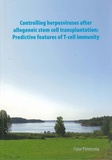Controlling herpesviruses after allogeneic stem cell transplantation
Predictive features of T-cell immunity

Pietersma, Floor
- Promoter:
- Prof.dr. F. (Frank) Miedema
- Co-promoter:
- Dr D. (Debbie) van Baarle & dr E. (Ellen) Meijer
- Research group:
- Baarle
- Date:
- March 17, 2011
- Time:
- 10:30 h
Summary
Infections with herpesviruses such as cytomegalovirus and Epstein-Barr virus occur often during childhood and have an asymptomatic course. After primary infection, both viruses persist lifelong in the host where there is a tightly regulated balance between virus infected cells and control through cytotoxic T-cell responses. During the immunosuppressed state following allogeneic stem cell transplantation, this balance is disrupted and reactivation of these viruses can lead to serious complications such as post transplant lymphoproliferative disease or CMV disease. This thesis focuses on identifying features of T-cell immunity which can predict adequate, or on the other hand lack of control, of viral reactivations. We investigated the general T-cell reconstitution by looking at both the quantity and quality of the reconstitution as well as the virus specific T-cell reconstitution. We found that measuring T-cell functionality shortly after transplantation is more important in determining adequate T-cell immunity than measuring absolute T-cell numbers. For example, we found an association between early expression of the cytotoxic molecule perforin in CD8+ T cells and subsequent severe viral reactivations. This could therefore provide a new tool for identifying patients at risk of viral complications early after SCT. The studies described in this thesis provide insight in the role of T-cell immunity in onset of viral reactivation after allogeneic stem cell transplantation as well as the role of general and virus specific T-cell reconstitution in reactivation severity.